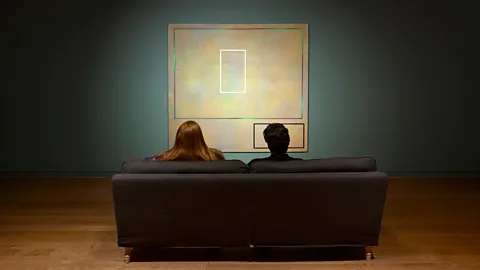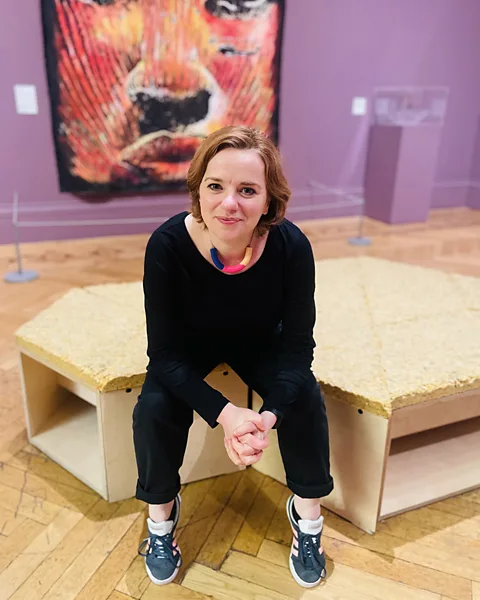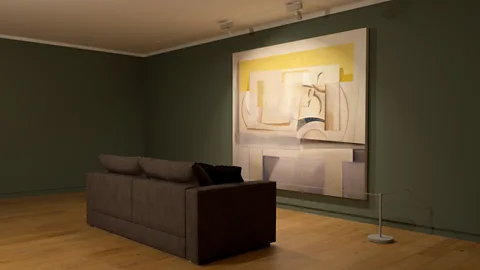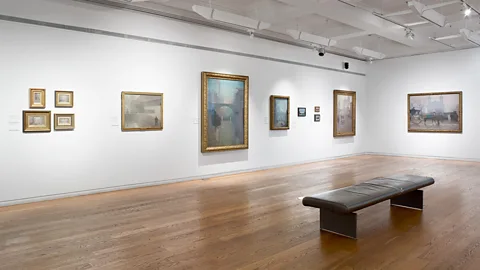The new museum trend helping us regain our lost attention
 Manchester Art Gallery/ Michael Pollard
Manchester Art Gallery/ Michael PollardIn a Manchester art gallery, a quiet room with just three paintings is starting a mental health movement aimed at reclaiming our lost attention spans.
There's a small, dark green room in Manchester Art Gallery, right next to a packed gallery of L S Lowry's stick figures and factory buildings. While people mill around in the bright space, as busy as the artist's workers outside the city's factories, in the dark green room they slow right down. They sit and look at the three paintings on the wall and really see them. Guided by a downloadable meditation, visitors are encouraged to spend up to 15 minutes with their chosen artwork, one on one.
In a world where demands for our eyeballs dominate and attention is the resource, this single-minded space, called Room to Breathe, is a place where you can regain your focus. It's all part of the Mindful Museum Campaign led by museum consultant Louise Thompson.
Over the past 12 years, Thompson has worked as the health and wellbeing manager at Manchester Art Gallery, developing the idea of a mindful museum, and she now consults with museums around the world. Her radical view is that a museum or art gallery are not just a place to store and exhibit items, but a public space where you can improve your mental health.
"Museums are places where social connection thrives in lots of ways," she explains. "They're also spaces where we foster connection with our identity, through seeing objects in museums, which helps us grow a sense of ourselves and of belonging."
"The act of learning, which we find in museums, increases our confidence, our self-worth, our self-esteem, and it's a really big boost for mental health."
The other thing that happens in museums and galleries, she says, is that we take notice of the objects and the collections. That act of taking notice is all about being in the present moment – a cornerstone of mindfulness meditation.
 Robyn Saunders
Robyn SaundersSitting in the dark green room, I try it for myself. I take in the abstract lines, grey tones and mustard yellow of a Ben Nicholson still life, guided by a recording that asks me to breathe in and out, to notice what draws my attention and what I like and dislike.
The more I look, the more I see. The painting isn't as abstract as I first thought: shadows and shapes emerge; the edge of a cup, the curve of a plate. I feel much calmer than in the previous room where I'd felt animated and energised, looking at multiple paintings for a second or so at a time.
"It is an act between you and the object," says Thompson. "As a practitioner, you invite people in and ask them to sit and look at the object, guiding them to notice the formal elements within it."
Thoughtful Travel
Want to travel better? Thoughtful Travel is a series on the ways people behave while away, from ethics to etiquette and more.
You don't need to know anything about fine art to participate; it's about paying attention to what you can see in front of you. I'm not the only person to find it relaxing: Thompson has been collaborating with Aleksandra Igdalova from Goldsmiths University's psychology department to examine how art viewing in museums relates to engagement and well-being. They found that visitors who viewed the same works in the mindful Room to Breathe setting reported feeling more relaxed and more perceptually engaged versus those seeing the same works in a traditional gallery space.
Thompson has seen this in action.
"People become much less stressed," she said. "Their body language is a bit tense and tight when they first come in, and they are unwilling to talk to strangers. After 10-15 minutes, they physically change. Their bodies are looser, softer, and they're talking to the person next to them."
 Manchester Art Gallery/ Michael Pollard
Manchester Art Gallery/ Michael Pollard"They're also more connected to the object. They might start out thinking that the object or artwork is dull and wondering why on earth I've chosen it. But at the end of 10-15 minutes, they have completely changed their minds."
The implication is that the act of slowing down and taking time to notice allows you to see the beauty and interesting aspects of something you might have otherwise written off. It's an idea that has wider consequences: stopping to think and consider something – art, music, writing or something else – builds meaning. And the alternative, in our fast-paced, digitally driven lives, is that by not engaging fully with the moment, we never give ourselves the chance to enjoy it, engage with it or even see the beauty of it in the first place.
It all changes how a museum or art gallery functions. What if a museum is more than a collection of historical objects and becomes a place where you can learn something about yourself? What if an art gallery goes beyond a building full of paintings and becomes a mental health support that helps you think more clearly and calmly? And there's more: what if you could learn a mindfulness skill in a museum that could improve the rest of your life?
"The people that we've worked with over years and years have told us this, and I can personally testify to it," says Thompson, "if you learn this skill with an object or a painting, you start to use it in your everyday life as well. You start to notice the beauty and the simplicity of things. And it makes you appreciate them on a whole other level."
Other galleries have taken up the Mindful Museums approach. At the Van Gogh Museum in Amsterdam, mindful art viewing sessions were offered through 2024 as part of its Open Up With Vincent programme around mental health. With a focus on the artist's work and life, the sessions ran alongside yoga and guided art meditations, available on their YouTube channel.
More like this:
• The seven travel trends that will shape 2025
• The new travel retreats addressing depression and grief
• How will air pollution change where and when we travel?
In Haarlem, the Netherlands, the Museum of the Mind has its own version of Room to Breathe, using mindfulness and meditation techniques based on scientific research to explore a single painting; while at the Victoria Gallery & Museum in Liverpool, visitors can follow a mindfulness trail around the museum aimed at helping them savour moments, notice patterns and look with curiosity, allowing exhibits time to reveal themselves.
 Manchester Art Gallery/ Michael Pollard
Manchester Art Gallery/ Michael PollardIf you find yourself in an art gallery or museum without a mindfulness programme, you can still reap the benefits.
Thompson suggests finding a space where there are fewer people and pulling up a seat – often art galleries have small portable stools for guests at the front desk – and sitting with just one picture for 10-15 minutes. Breathe in and out slowly and start to look at the details of the artwork, the shapes, colours, the style, the areas that interest you, the areas that don't. Participate in the act of noticing and see how it changes your experience.
"It's great to see the Mona Lisa and have that on your bucket list, but I think that if you had 10 minutes with a less famous artwork, the experience would be far more beneficial and powerful," she says. "When you're on holiday, there's a part of you that wants to see everything you can. I'm always encouraging people to tick the boxes on your list but then choose one object while you're there and sit with it for 5-10 minutes."
It's an encouragement to step away from over touristed, overhyped artworks and even sights, and see if you can find the beauty in something by just paying attention. And then see what else that approach can do for you, your travels and your life.
--
If you liked this story, sign up for The Essential List newsletter – a handpicked selection of features, videos and can't-miss news, delivered to your inbox twice a week.
